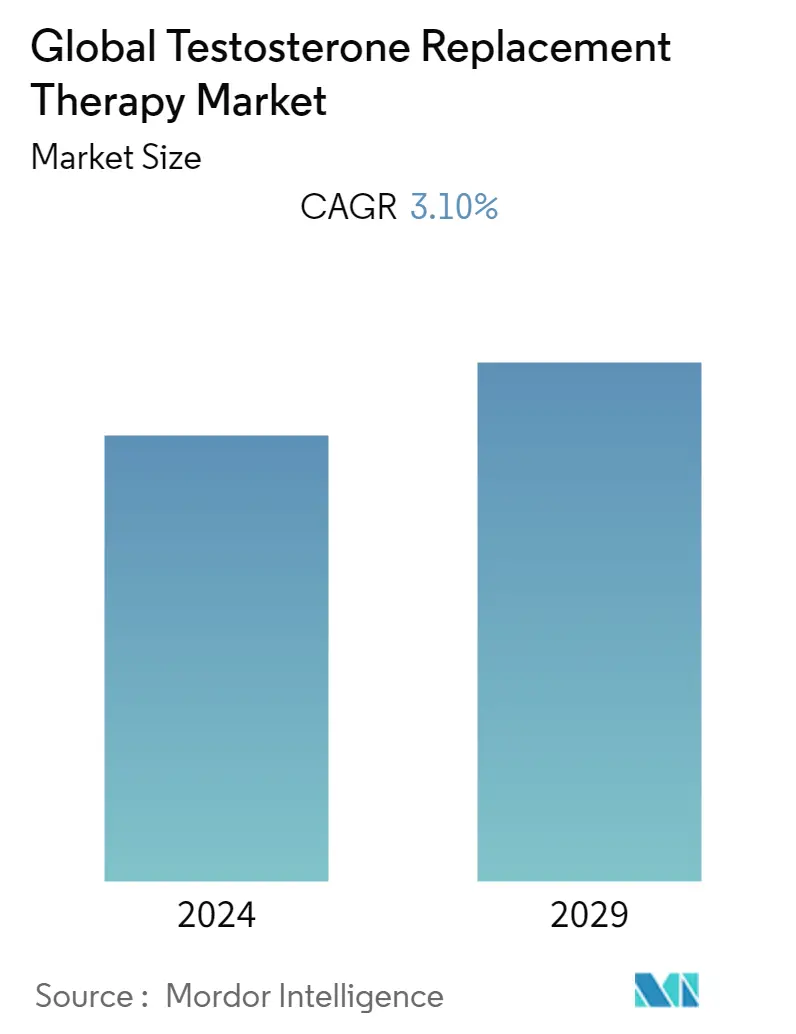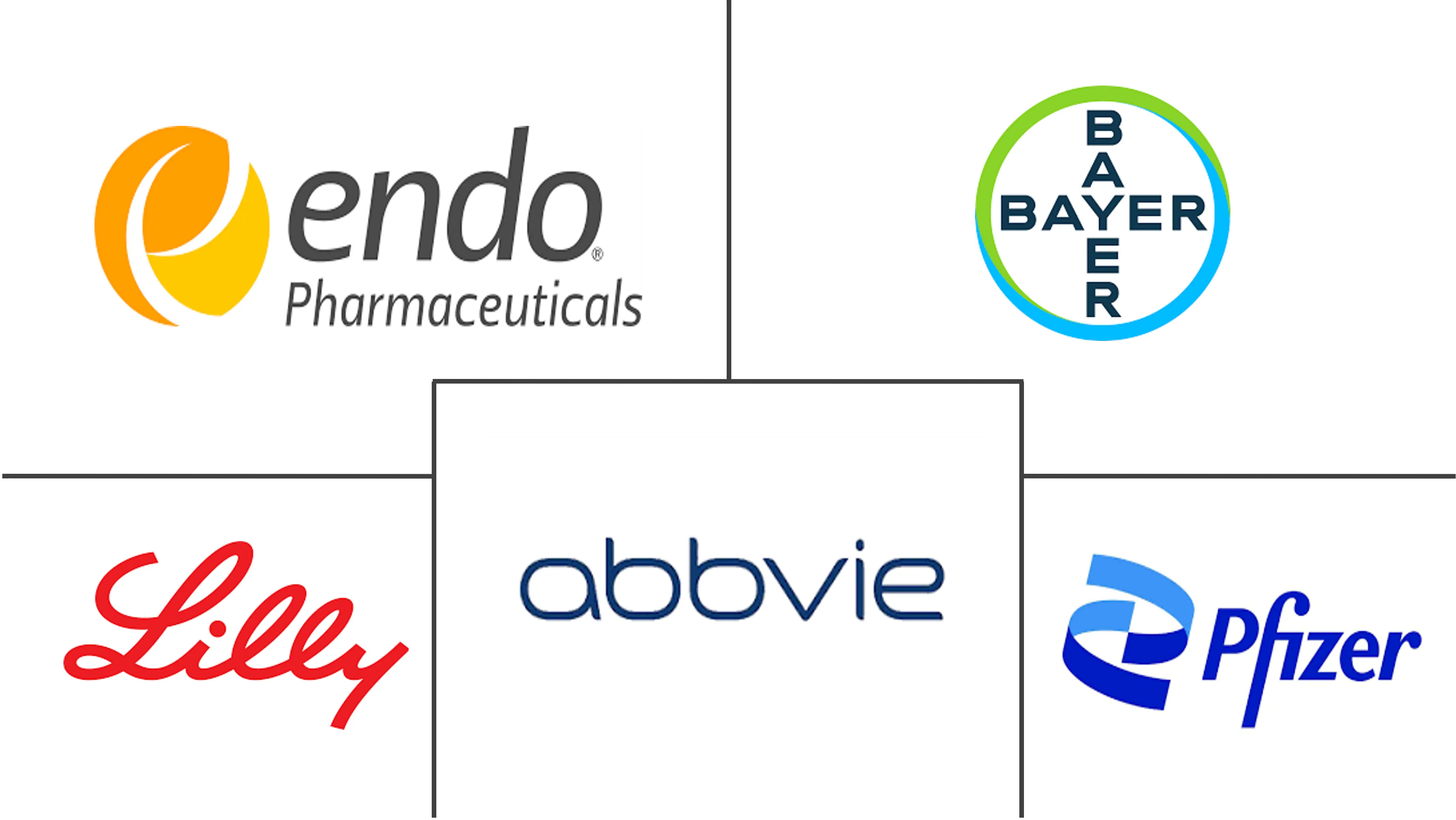Market Size of Global Testosterone Replacement Therapy Industry

| Study Period | 2019 - 2029 |
| Base Year For Estimation | 2023 |
| Forecast Data Period | 2024 - 2029 |
| CAGR | 3.10 % |
| Fastest Growing Market | Asia Pacific |
| Largest Market | North America |
Major Players
*Disclaimer: Major Players sorted in no particular order |
Testosterone Replacement Therapy Market Analysis
The Testosterone Replacement Therapy Market is expected to register a CAGR of 3.1% during the forecast period (2022-2027).
The COVID-19 pandemic has had unprecedented health concerns and negatively affected communities, industries, businesses, and health worldwide and is still affected by the spread of new strains of the virus. As the COVID-19 epidemic has led to a decline in tourism due to job closures it has contributed to market growth. Research studies showing the relationship between testosterone and COVID-19 have also contributed to market growth. For example, an article in the Journal of the American Medical Association entitled 'Association for Circulating Sexual Hormones and Inflammation and Disease in Patients With COVID-19' published in May 2021 reported that patients with COVID-19 low testosterone concentration during hospitalization was associated with the ascent severity of disease and inflammation in men. Such studies show that COVID-19 increases the need for testosterone treatment and will stimulate market growth. On the other hand, some studies have suggested that during COVID-19, Testosterone Replacement Therapy (TRT) should be discontinued and thus hinder the market growth. For example, an article on Therapeutic Ádvances in Endocrinology and Metabolism entitled 'Systemic effects of male hypogonadism hormone therapy with early indications for COVID-19 patient management' published in October 2020 reported that TRT may be temporarily discontinued in patients with COVID-19 and hypogonadism. Androgen deprivation Therapy (ADT) may be considered in severe cases without hypogonadism to counteract the effect of androgens on SARS-CoV2 infection. Such studies suggesting discontinuation of treatment could impede the market growth.
Testosterone replacement therapy involves the administration of testosterone through creams/gels, patches, injections, gums/buccal adhesives, or implants. Testosterone is a major male hormone responsible for improving male sexual characteristics, spermatogenesis, and reproduction. Insufficient production of testosterone causes erectile dysfunction. Erectile dysfunction occurs due to a decrease in testosterone production to overcome this treatment instead of testosterone being used to improve the problem. Testosterone deficiency or hypogonadism is a common problem among men between 40 and 79 years of age. Several research studies have shown the incidence and prevalence of testosterone deficiency in people of different regions and emphasized the fact that aging is strongly associated with increased incidence. For example, an article in the European Journal of Endocrinology titled 'Active hypogonadism in middle-aged men: testosterone treatment or not?' published in August 2021, reported that Functional hypogonadism, in older men, also called late hypogonadism is common to tested persons. It also reported that the prevalence of active hypogonadism was approximately 2.1% with a strong diagnostic procedure. In addition, the prevalence increases with age, occurring in 0.6% of men aged 50-59, increasing to 5.1% in men aged 70-79. Such an increase in load over time is expected to further market growth in the forecast period.
Additionally, an Indian Journal of the Endocrinology and Metabolism article entitled 'Prevalence of Testosterone Deficiency in Elderly Male and its Association with Frailty and Mobility at a Tertiary Care Centre' published in December 2021 reported an increase in testosterone deficiency by 21.67% in older men over 60 years of age. As men get older, their androgen levels gradually decrease. Such proliferation of testosterone creates a need for treatment instead of testosterone and thus furthers market growth.
Therefore, due to the increase in the elderly, unhealthy lifestyle, and disease burden, the incidence of testosterone deficiency is expected to increase which will enhance the growth of the testosterone replacement therapy market in the predictive period. However, the side effects of testosterone replacement therapy and strict product approval rules will hinder the market growth.
Testosterone Replacement Therapy Industry Segmentation
As per the scope of the report, testosterone replacement therapy (TRT) is a form of hormone therapy in which androgens testosterone, is replaced and this therapy is often prescribed to counter the effects of male hypogonadism. The Testosterone Replacement Therapy Market has segmented By Product Type (Injectables, Topicals, Others) and Geography (North America, Europe, Asia-Pacific, Middle East and Africa, and South America). The market report also covers the estimated market sizes and trends for 17 different countries across major regions, globally. The report offers the value (in USD million) for the above segments.
| By Product Type | |
| Injectables | |
| Topicals | |
| Others |
| Geography | ||||||||
| ||||||||
| ||||||||
| ||||||||
| ||||||||
|
Global Testosterone Replacement Therapy Market Size Summary
The Testosterone Replacement Therapy (TRT) market is poised for growth, driven by an increasing prevalence of testosterone deficiency, particularly among older men. This condition, often linked to aging, unhealthy lifestyles, and disease burden, has led to a rising demand for TRT solutions. The market is characterized by the administration of testosterone through various methods such as creams, gels, patches, injections, and implants, aimed at addressing issues like erectile dysfunction and hypogonadism. Despite the potential for market expansion, challenges such as the side effects of therapy and stringent regulatory approvals may impede growth. The COVID-19 pandemic has had a mixed impact, with some studies suggesting a heightened need for TRT due to low testosterone levels in infected patients, while others recommend discontinuation, creating a complex landscape for market dynamics.
In the United States, the TRT market is further bolstered by a well-established healthcare infrastructure and ongoing research and development efforts. The introduction of new products and strategic acquisitions by key players are significant contributors to market expansion. Regulatory approvals for new therapies, such as oral testosterone undecanoate, have also played a crucial role in enhancing market share. Major companies like AbbVie Inc, Endo Pharmaceuticals Inc, and Pfizer Inc dominate the market, leveraging their extensive portfolios and innovative solutions to maintain a competitive edge. As the incidence of testosterone deficiency continues to rise, the market is expected to experience sustained growth, supported by advancements in therapeutic approaches and a focus on addressing the needs of affected populations.
Global Testosterone Replacement Therapy Market Size - Table of Contents
-
1. MARKET DYNAMICS
-
1.1 Market Overview
-
1.2 Market Drivers
-
1.2.1 Rise in Incidence of Testosterone Deficiency
-
1.2.2 Increasing Novel Therapeutic Approaches
-
-
1.3 Market Restraints
-
1.3.1 Adverse Effects of the Testosterone Replacement Therapy
-
1.3.2 Stringent Regulations on Product Approval
-
-
1.4 Porter's Five Force Analysis
-
1.4.1 Threat of New Entrants
-
1.4.2 Bargaining Power of Buyers/Consumers
-
1.4.3 Bargaining Power of Suppliers
-
1.4.4 Threat of Substitute Products
-
1.4.5 Intensity of Competitive Rivalry
-
-
-
2. MARKET SEGMENTATION (Market Size by Value - USD million)
-
2.1 By Product Type
-
2.1.1 Injectables
-
2.1.2 Topicals
-
2.1.3 Others
-
-
2.2 Geography
-
2.2.1 North America
-
2.2.1.1 United States
-
2.2.1.2 Canada
-
2.2.1.3 Mexico
-
-
2.2.2 Europe
-
2.2.2.1 Germany
-
2.2.2.2 United Kingdom
-
2.2.2.3 France
-
2.2.2.4 Italy
-
2.2.2.5 Spain
-
2.2.2.6 Rest of Europe
-
-
2.2.3 Asia-Pacific
-
2.2.3.1 China
-
2.2.3.2 Japan
-
2.2.3.3 India
-
2.2.3.4 Australia
-
2.2.3.5 South Korea
-
2.2.3.6 Rest of Asia-Pacific
-
-
2.2.4 Middle East and Africa
-
2.2.4.1 GCC
-
2.2.4.2 South Africa
-
2.2.4.3 Rest of Middle East and Africa
-
-
2.2.5 South America
-
2.2.5.1 Brazil
-
2.2.5.2 Argentina
-
2.2.5.3 Rest of South America
-
-
-
Global Testosterone Replacement Therapy Market Size FAQs
What is the current Global Testosterone Replacement Therapy Market size?
The Global Testosterone Replacement Therapy Market is projected to register a CAGR of 3.10% during the forecast period (2024-2029)
Who are the key players in Global Testosterone Replacement Therapy Market?
AbbVie Inc, Endo Pharmaceuticals Inc, Pfizer, Inc, Eli Lilly and Company and Bayer AG are the major companies operating in the Global Testosterone Replacement Therapy Market.

